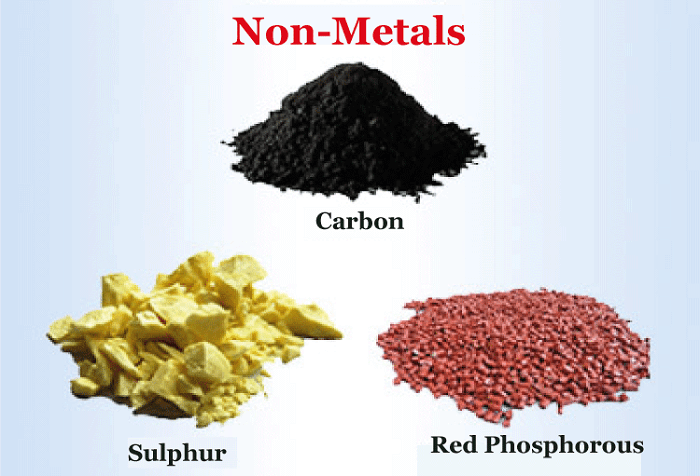Metals, Non-Metals and Metalloids
Subject: Science

Overview
The periodic table categorizes elements into metals, nonmetals, and metalloids based on their metallic characteristics. Metals are the most reactive, with elements in groups IA through IIIA. Transitional metals, such as Fe, Co, Ni, Ag, Au, Hg, and Zn, are excellent electrical and thermal conductors. Nonmetals, on the other hand, include elements in groups VIIIA or 18 (0), VA, VIA, and VIIA. Metalloids, which are elements between metals and nonmetals, have properties similar to metals but less electrical conductivity. They are the poorest generators of electricity.
Based on their metallic characteristics, elements are categorized as metals, nonmetals, or metalloids.
Metal
On the left side of the current periodic table are metals. Except for boron, every element in groups IA through IIIA is a metal. Compared to the metals in group IA, the metals in groups IIA and IIIA are less reactive. Group IIIB to IIB elements are transitional metals with lower reactivity. Fe, Co, Ni, Ag, Au, Hg, Zn, etc. are a few examples. They are also referred to as transitional metals, as their characteristics fall between those of active metals and nonmetals. Metals are excellent electrical and thermal conductors.
Group IA is made up of elements with a single electron in their outermost shell. Li, Na, and K are examples of elements in this category. These metals are reactive. They are sometimes referred to as alkali metals because, when dissolved in water, they generate a strong base or alkali. They have a ns1 electronic valence shell arrangement. 'n' indicates the shell in this case. As an illustration, the electrical structure of sodium is 1s2, 2s2, 2p6, and 3s1. This group's constituents are less dense and moist.
Group IIA is made up of elements with two electrons in their outermost shell. This category includes elements like magnesium and calcium. They have a ns2 electronic valence shell structure. For instance, magnesium has the electrical structure 1s2, 2s2, 2p6, and 3s2. Since the oxides of the elements in this group are soluble in water and are present on the surface of the planet, they are referred to as alkaline earth metals.
Non-metal
Nonmetals are kept on the right side of the periodic table. The group of elements of VA, VIA, and VIIA, along with elements of group VIIIA, or 18 (0), are non-metals.
The periodic table's right side is devoted to nonmetals. Non-metals include elements of groups VIIIA or 18 (0), as well as elements of VA, VIA, and VIIA.
The elements in VIIA (17) of the current periodic table have seven electrons in their valence shell. This group includes elements including F, Cl, Br, and I. These elements readily participate in reactions in order to complete their valence shell with eight electrons by gaining one group electron from other elements. They are therefore very reactive. The notations ns2 and np5 denotes these elements' outermost electronic configuration. Chlorine, for instance, has the following electrical configuration: 1s2, 2s2, 2p6, 3s2, 3p5. This group's elements (F, Cl, Br, and I) are referred to as halogens. This group's constituents are less dense and mushy. The most reactive nonmetals are these ones.
This group's constituents are less dense and mushy. The most reactive nonmetals are these ones.Group 0 is made up of elements with eight electrons in the valence shell and two electrons in the first shell, which doubles as the valence shell. This group contains elements such as He, Ne, Ar, Kr, Xe, and Rn. The symbols ns2 and np6 stand for these elements' valence shell electrical arrangement. Argon, for instance, has the following electrical configuration: 1s2, 2s2, 2p6, 3s2, 3p6. These substances are sometimes referred to as inert gases or noble gases. They are referred to as inert gases because they have octet states in their valence shells and do not participate in chemical processes.
Metalloid
The elements that lie between metals and nonmetals in the periodic table and show some properties similar to metals and some properties similar to nonmetals are called metalloids. They are the poorest generators of electricity. Their electrical conductivity is less than metals and more than nonmetals. Silicon (Si), germanium (Ge), bismuth (Bi), etc. are metalloids.
Things to remember
- The periodic table categorizes elements into metals, nonmetals, and metalloids based on their metallic characteristics.
- Metals are the most reactive, with elements in groups IA through IIIA being the most reactive.
- Nonmetals are on the right side, including elements of groups VIIIA or 18 (0), VA, VIA, and VIIA.
- Metalloids, which lie between metals and nonmetals and show properties similar to metals and nonmetals, are the poorest generators of electricity, with electrical conductivity less than metals and more than nonmetals.
© 2021 Saralmind. All Rights Reserved.


 Login with google
Login with google